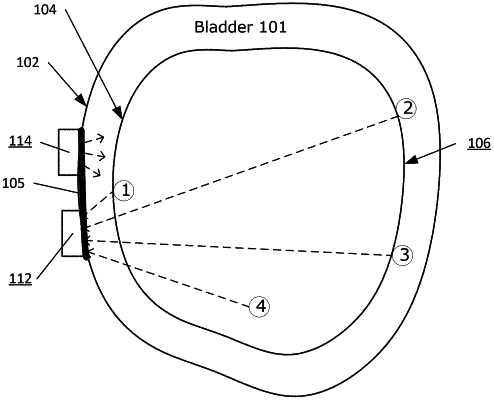| CPC A61B 5/204 (2013.01) [A61B 5/0059 (2013.01); A61B 5/0075 (2013.01); A61B 5/205 (2013.01); A61B 5/391 (2021.01); A61B 5/6837 (2013.01); A61B 5/6874 (2013.01); A61B 5/486 (2013.01); A61B 5/7282 (2013.01); A61B 5/742 (2013.01)] | 28 Claims |

|
1. A bladder monitoring system comprising:
a sensor device fixedly positionable on an external wall of the bladder without piercing an internal wall of the bladder, the sensor device including (i) a light emitter positioned at the external wall of the bladder to emit light to targeted regions within the bladder in a plurality of wavelength ranges, and (ii) a detector positioned to detect reflected emitted light based on the emitted light,
wherein, in a first mode, the light emitter targets the emitted light, in a first of the plurality of wavelength ranges, to a first region of the targeted regions between the external wall and the internal wall of the bladder to determine bladder fullness based on a correlation between light reflected back to the detector and fullness of the bladder,
wherein, in a second mode, the light emitter targets the emitted light, in a second of the plurality of wavelength ranges, from a proximal wall of the bladder relative to the sensor device to a second region of the targeted regions that coincides with a distal interior wall of the bladder to determine a time of flight measurement based on the light reflected back from the distal interior wall to calculate distance between the proximal wall and the distal wall;
wherein, in a third mode, the light emitter targets the emitted light to a third region of the targeted regions. the third region being submerged below a fluid level in the bladder, to determine differences in refractive index between wall tissue of the bladder and liquid contents of the bladder;
wherein the sensor device generates an output signal that is indicative of the reflected emitted light detected by the detector; and
a controller operatively coupled to the sensor device, the controller including logic executed by one or more processors of the controller, causing the one or more processors to:
select the targeted region for directing the emitted light such that different types of information can be determined about the bladder, the targeted region being selected from possibilities including the first region, the second region, or the third region;
operate the sensor device in the first mode to receive the output signal from the sensor device in the first mode indicative of the fullness of the bladder;
operate the sensor device in the second mode to receive the output signal from the sensor device in the second mode indicative of the distance between the proximal wall and the distal wall; and
operate the sensor device in the third mode to receive the output signal from the sensor device in the third mode indicative of the differences in the refractive index between the wall tissue of the bladder and the liquid contents of the bladder.
|